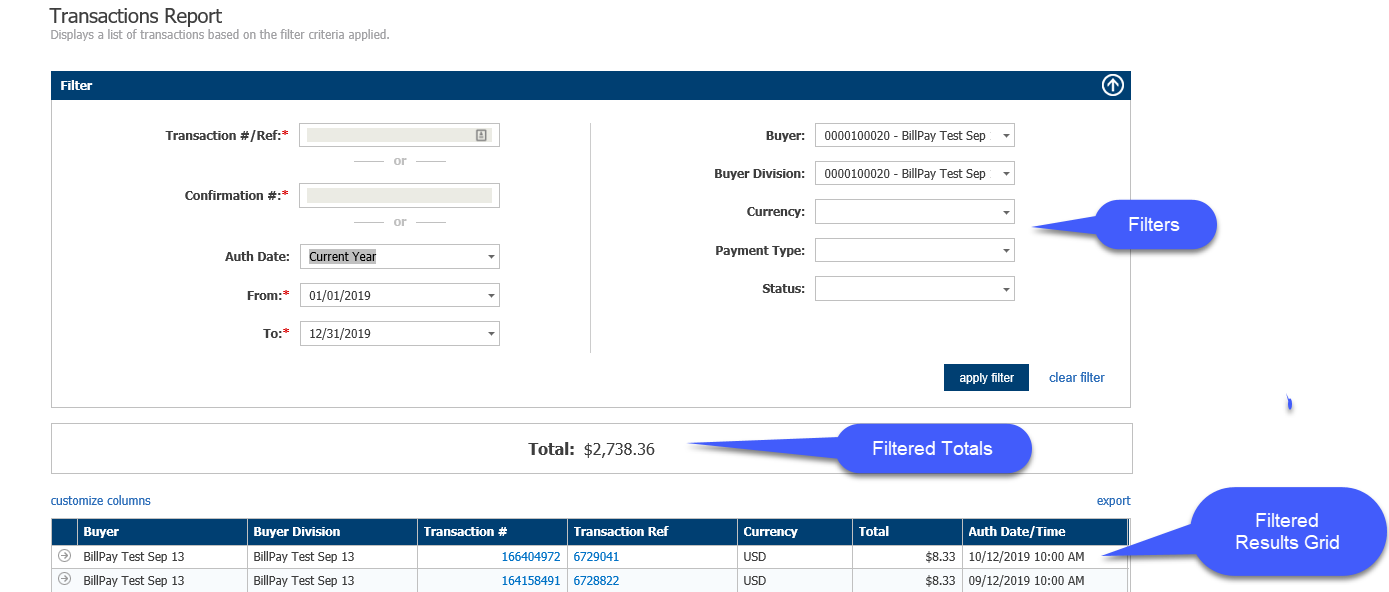Transactions Report
The Transaction Report page is accessed from the Reports menu. There are three main areas of this report page as follows:
-
Filter – Various fields used to specify the search criteria for the transactions you wish to view. There are minimum required filters to run the report. These are identified in the "Filters" section below.
-
Filtered Summary Amount – Contains the sum total across all transactions based on the filter criteria applied.
-
Filtered Results Grid – Contains the list of transactions returned based on the filter criteria applied. The list may span multiple pages; this is indicated at the bottom of the grid.

Field descriptions: filters
There are minimum, required filter fields; these are identified in the following table.
|
Field name |
Description |
|---|---|
|
Transaction #/Ref |
CONDITIONAL. Only required if not entering Confirmation # or Auth Date. The XiPay Transaction ID or unique BillPay generated identifier for the transaction. |
|
Confirmation # |
CONDITIONAL. Only required if not entering Transaction #/Ref or Auth Date. The BillPay generated identifier for a given payment. |
|
Auth Date - From/To |
CONDITIONAL. Only required if not entering Transaction #/Ref or Confirmation #. Select one of the date radio buttons and complete the From and To fields or select a date range from the dropdown list above the "From:" field. |
|
Buyer |
OPTIONAL. The customer. |
|
Buyer Division |
OPTIONAL. A logical grouping of the Buyer's transactions based on the Merchant's business needs. This could be by location or perhaps some sort of business division. This field only displays if you have multiple Buyer Divisions. |
|
Currency |
OPTIONAL. The currency of the transaction. |
|
Payment Type |
OPTIONAL. Select the method of payment from the dropdown list. This list contains all potential payment types including payments/transactions uploaded directly by the Merchant. This means you will see some additional ones other than the Payment Types that are configured for payments made through the BillPay Portal, for example "Cash" or "Other". The usage of these Payment Type descriptions is up to the Merchant's discretion. |
|
Status |
OPTIONAL. Click to expand the full list of Transaction Status Codes:
|
Field descriptions: summary amounts
The Summary Total includes all transactions returned based on the filters applied.
Total = The total amount across all transactions returned based on the filter(s) applied. Includes any fees if applicable (e.g., surcharge/convenience fee).
Field descriptions: filtered results grid
The results list returned for this report includes the following Transaction related information.
To see the Invoice(s) related to a given Transaction, click the right-arrow icon to the left of the Transaction # to expand that section.
If enabled, you will see an export option on the upper right-side of the results grid.
|
Field name |
Description |
|---|---|
|
# Invoices |
The number of Invoices associated with the Transaction. |
|
Account Holder |
Name on the card or account. |
|
Account Number |
Displays the masked account number (credit card or echeck) used for the transaction. |
|
Auth Code |
The authorization code received from the Payment Processor. |
|
Auth Date / Time |
The date and time of the authorization. |
|
Buyer |
Optional entity in the BillPay system to which Invoices are associated. Buyers are created in BillPay via Batch or RESTful API processing from the ERP system. A Merchant can choose to NOT implement Buyers in BillPay and use a custom field to associate invoices to Customers. |
|
Buyer Division |
Optional entity in the BillPay system that allows for a logical grouping of the Buyer's invoices/payments based on the Merchant's business needs. A Merchant or Buyer (if allowed by the Merchant) can limit which invoices a given Buyer user can access. This could be by location or perhaps some sort of business division. |
|
Buyer Division Merch Ref |
The reference ID associated with the Buyer Division. |
|
Buyer Ref |
The reference ID associated with the Buyer. |
|
Convenience Fee |
The convenience fee amount for the transaction. This column only displays if the Merchant supports convenience fees, or if a fee exists for any transaction in the results list. |
|
Currency |
The currency of the transaction. |
|
Notes |
Displays any notes (if available) that were entered when submitting a prepayment, voiding a transaction, or issuing a credit. Only notes that were entered on the portal will display; notes entered via the API will not display on the portal. |
|
Payment Type |
Displays the payment method used for the transaction. |
|
Source System |
The source system of the transaction. |
|
Status |
The state of the transaction in XiPay. |
|
Status Code |
Contains just the corresponding code for the Status. |
|
Subtotal |
The amount of the transaction minus any fees (surcharge or convenience fee). |
|
Surcharge |
The surcharge amount for the transaction. This column only displays if the Merchant supports surcharges, or if a surcharge exists for any transaction in the results list. Surcharges apply to credit card transactions only. Surcharges do not apply to echecks or debit cards. |
|
Total |
The total amount of the transaction including any fees. |
|
Transaction # |
The XiPay Transaction ID. Only populated if the transaction was authorized through XiPay either through BillPay or other method. |
|
Transaction Ref |
Unique identifier for a transaction regardless of the transaction source. All transactions will have this identifier. |
|
User |
Email address of the user that generated the transaction. |
|
XIID |
Unique ID that represents the XiPay Payment Configuration. Also referred to as a XiPay Server ID. |